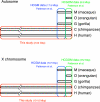An autosomal analysis gives no genetic evidence for complex speciation of humans and chimpanzees
- PMID: 21903679
- PMCID: PMC3299331
- DOI: 10.1093/molbev/msr172
An autosomal analysis gives no genetic evidence for complex speciation of humans and chimpanzees
Abstract
There have been conflicting arguments as to what happened in the human-chimpanzee speciation event. Patterson et al. (2006, Genetic evidence for complex speciation of humans and chimpanzees. Nature 441:1103-1108) proposed a hypothesis that the human-chimpanzee speciation event involved a complicated demographic process: that is, the ancestral lineages of humans and chimpanzees experienced temporal isolation followed by a hybridization event. This hypothesis stemmed from two major observations: a wide range of human-chimpanzee nucleotide divergence across the autosomal genome and very low divergence in the X chromosome. In contrast, Innan and Watanabe (2006, The effect of gene flow on the coalescent time in the human-chimpanzee ancestral population. Mol Biol Evol. 23:1040-1047) demonstrated that the null model of instantaneous speciation fits the genome-wide divergence data for the two species better than alternative models involving partial isolation and migration. To reconcile these two conflicting reports, we first reexamined the analysis of autosomal data by Patterson et al. (2006). By providing a theoretical framework for their analysis, we demonstrated that their observation is what is theoretically expected under the null model of instantaneous speciation with a large ancestral population. Our analysis indicated that the observed wide range of autosomal divergence is simply due to the coalescent process in the large ancestral population of the two species. To further verify this, we developed a maximum likelihood function to detect evidence of hybridization in genome-wide divergence data. Again, the null model with no hybridization best fits the data. We conclude that the simplest speciation model with instantaneous split adequately describes the human-chimpanzee speciation event, and there is no strong reason to involve complicated factors in explaining the autosomal data.
Figures





Similar articles
-
Doubts about complex speciation between humans and chimpanzees.Trends Ecol Evol. 2009 Oct;24(10):533-40. doi: 10.1016/j.tree.2009.04.007. Epub 2009 Aug 5. Trends Ecol Evol. 2009. PMID: 19664844 Free PMC article.
-
Genetic evidence for complex speciation of humans and chimpanzees.Nature. 2006 Jun 29;441(7097):1103-8. doi: 10.1038/nature04789. Epub 2006 May 17. Nature. 2006. PMID: 16710306
-
Complex speciation of humans and chimpanzees.Nature. 2008 Mar 13;452(7184):E3-4; discussion E4. doi: 10.1038/nature06805. Nature. 2008. PMID: 18337768
-
Evolutionary biology: how did the human species form?Curr Biol. 2006 Aug 22;16(16):R647-50. doi: 10.1016/j.cub.2006.07.032. Curr Biol. 2006. PMID: 16920616 Review.
-
Understanding the recent evolution of the human genome: insights from human-chimpanzee genome comparisons.Hum Mutat. 2007 Feb;28(2):99-130. doi: 10.1002/humu.20420. Hum Mutat. 2007. PMID: 17024666 Review.
Cited by
-
Mitochondrial Pseudogenes Suggest Repeated Inter-Species Hybridization among Direct Human Ancestors.Genes (Basel). 2022 May 1;13(5):810. doi: 10.3390/genes13050810. Genes (Basel). 2022. PMID: 35627195 Free PMC article.
-
Embodied niche construction in the hominin lineage: semiotic structure and sustained attention in human embodied cognition.Front Psychol. 2014 Aug 1;5:834. doi: 10.3389/fpsyg.2014.00834. eCollection 2014. Front Psychol. 2014. PMID: 25136323 Free PMC article.
-
Consistency and inconsistency of consensus methods for inferring species trees from gene trees in the presence of ancestral population structure.Theor Popul Biol. 2016 Aug;110:12-24. doi: 10.1016/j.tpb.2016.02.002. Epub 2016 Apr 13. Theor Popul Biol. 2016. PMID: 27086043 Free PMC article.
-
Evolutionary origins of human herpes simplex viruses 1 and 2.Mol Biol Evol. 2014 Sep;31(9):2356-64. doi: 10.1093/molbev/msu185. Epub 2014 Jun 10. Mol Biol Evol. 2014. PMID: 24916030 Free PMC article.
-
A new isolation with migration model along complete genomes infers very different divergence processes among closely related great ape species.PLoS Genet. 2012;8(12):e1003125. doi: 10.1371/journal.pgen.1003125. Epub 2012 Dec 20. PLoS Genet. 2012. PMID: 23284294 Free PMC article.
References
Publication types
MeSH terms
LinkOut - more resources
Full Text Sources

